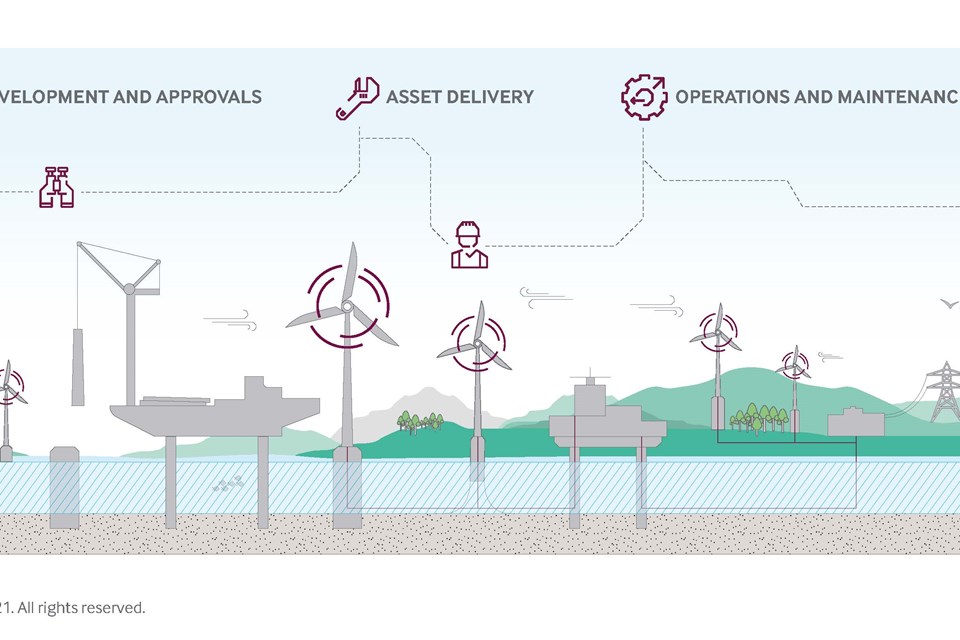Offshore wind Korea: Obtaining a local and international licence to operate
In Korea, each new offshore wind project will need to navigate the critical first step of obtaining the much needed environmental permits and licences. This will require a deep understanding of both the local EIA regulations, whilst also meeting the expectations and standards of international finance (ESIA).
South Korea's Green New Deal
South Korea’s Green New Deal aims to accelerate the transition towards net-zero by 2050, mitigate the risks associated with climate change and to expand offshore wind capacity to 12 GW by 2030. The Offshore Wind Collaboration Plan, which was jointly issued in July 2020 by the Ministry of Trade, Industry and Energy (MOTIE), the Ministry of Oceans and Fisheries (MOF) and the Ministry of Environment (MOE) will support this transition. This Plan sets out specific measures to encourage the speedy development of large-scale offshore wind farms and associated benefits to local stakeholders.
As these ambitious policies and measures drive the industry forward, the number of offshore wind projects progressing will increase. Each project will need to navigate the development process, including the critical first step of obtaining all the required permits and licences. Underpinning these permits will be environmental impact assessments that will require a deep understanding of both the local Korean regulations, whilst also meeting the expectations and standards of international finance.
Offshore wind asset lifecycle
Offshore wind projects around the world will progress through a series of asset lifecycle stages – from pre-asset evaluation through to late life.
During the early stages of development, the focus will be on obtaining the relevant permits and licences required to construct and operate the offshore wind farm project. Permit applications are typically supported by an Environmental Impact Assessment (EIA) – the process by which an assessment is made of the potential of the project to impact on the physical, biological and human environment. An offshore wind EIA is typically supported by a series of technical studies evaluating subjects such as (but not limited to) commercial fisheries, marine mammals, ornithology, marine traffic, marine ecology – alongside a series of marine environmental surveys.
Once all the relevant permits and licences have been granted and the project reaches financial close, the development moves into the Construction phase. At the point of commissioning, the project is handed over to Operations and Maintenance (O&M).
During the EIA process, several environmental measures may be stipulated and require implementation during the project execution, O&M and potentially the late life phases. The measures will likely be aimed at managing any potentially adverse environmental impacts. So, while the EIA process occurs early in a project’s development, it has an influence over the asset across its lifecycle.
Download our Offshore Wind services brochure, available in English or Korean.
The Environmental Impact Assessment (EIA)
A robust and clearly defined EIA process is critical to the long-term sustainability of the asset, and the industry as a whole. The process provides assurance to developers, government and its agencies, wider stakeholders and the general public that the potential environmental impacts of the development have been assessed and measures have been incorporated into the project to minimise any potential impacts.
Around the world, the offshore wind industry has a strong track record in understanding and managing how developments interact with their surrounding environment.
Internationally, the offshore wind EIA process typically uses a systematic, evidence-based approach to evaluate and interpret the likely impacts of project activities on the environment. The EIA process will typically:
- Provide consultees with technical information to enable an understanding of the project
- Provide an understanding of the existing localised environment
- Describe the methodology used within the EIA process
- Present the potential environmental impacts because of the project
- Propose potential mitigation measures that could prevent, minimise, reduce or offset potential adverse environmental impacts identified
- Provide an indication of the main reasons for the project selection
Local versus international ESIA requirements
To obtain permits to construct and operate a project, first and foremost the development must complete an EIA compliant with the local regulations in each country (a ‘local’ EIA). However, to obtain external financing, a project may require additional impact assessment work, over and above what is required by local laws. This requirement can be fulfilled via the completion of an ‘International ESIA’ (Environmental and Social Impact Assessment) designed to be compliant with the requirements of the Equator Principles.
The Equator Principles provide a common framework for assessing and managing environmental and social risks when financing projects and are adopted by most International Financial Institutions. In the area of social and environmental assessments and standards, the Equator Principles are underpinned by International Finance Corporation (IFC) Performance Standard. In some countries in Asia, the scope of an ESIA required under IFC Performance Standards is broader than that required by local law. The Equator Principles Financial Institutions (EPFIs) will not provide project finance to developments who do not comply with the relevant Equator Principles.
For this reason, in South Korea, it is important for projects to consider requirements of the local EIA to meet Korean regulations, alongside the requirements of an International ESIA to obtain finance when embarking on the development. In our experience, projects will significantly benefit from the development of a permitting strategy at the outset, that considers the differing requirements of each EIA.
Successfully navigating this process requires knowledge and insight into the local regulatory requirements for offshore wind EIA, alongside a deep understanding of the reviewed Equator Principles and IFC Performance Standards. It is a significant benefit for both aspects to be underpinned by a track record of successfully delivering EIA’s for large scale offshore wind development in countries with demanding permitting requirements. This provides the experience to efficiently comply with differing requirements of the local and bankable ESIA and successfully navigate this stage in the development lifecycle.
The requirements for a ‘local consent’ in South Korea
Offshore wind developers in South Korea seeking permits for the construction of renewable energy projects listed under the EIA Act are required to prepare an EIA. This requirement includes not only input from residents located in the vicinity of the project but also a fundamental baseline survey of 4 seasons (12 months) considering seasonal characteristics and changes in marine environment and ecological systems. The EIA application should be submitted to the relevant government authority, the Ministry of Trade, Industry and Energy (MOTIE), along with the necessary consenting and permitting process in accordance with the guidelines and regulations of the local EIA Act. The MOTIE must send a request for consultation to the Ministry of Environment (MOE) before granting the permit. The MOE has the main responsibility and authority to review the EIA report together with other relevant parties and must notify the result of its review, which is typically made in the form of "approval", "not approved" or "conditional approval". The applicant must consider the results of this consultation and their impact on its construction plans with proper mitigation plans/actions or alternative solutions.
The requirement of the international ESIA: Project Finance
The revised Equator Principles, known as EP4, apply to more financial products, and project financings globally. These Principles require project-related risks to be evaluated against the IFC Performance Standards and not simply the assessment of compliance with domestic laws.
The IFC Performance Standards provide a framework for ensuring sustainable development in emerging economies. From an Environmental and Social Sustainability perspective, they define a developer’s responsibility for managing the environmental and social risks and impacts of a project. The standards are designed to help avoid, mitigate, and manage risks and impacts as a way of doing business in a sustainable way. There are eight Performance Standards that the client is to meet throughout the life of an investment:
- Performance Standard 1: Assessment and Management of Environmental and Social Risks and Impacts
- Performance Standard 2: Labour and Working Conditions
- Performance Standard 3: Resource Efficiency and Pollution Prevention
- Performance Standard 4: Community Health, Safety, and Security
- Performance Standard 5: Land Acquisition and Involuntary Resettlement
- Performance Standard 6: Biodiversity Conservation and Sustainable Management of Living Natural Resources
- Performance Standard 7: Indigenous Peoples
- Performance Standard 8: Cultural Heritage
The challenges for Offshore Wind EIA in South Korea
Based on our understanding of the offshore wind market, there are several key challenges that will be faced by some of the early commercial scale offshore wind project to progress through the EIA process. These include:
Early project risks – for early commercial-scale offshore wind developments in South Korea, there are limited reference projects, precedents, and guidelines to draw upon for standard methodologies and accepted approaches for the assessment of OWFs.
Scaling up - in countries such as Denmark, Germany and the UK, there has often been a gradual scaleup in the size of offshore wind projects, whereby the early, smaller capacity projects have established standardised approaches for survey and assessment and the growth of the supply chain alongside the industry, allowing for significant economies of scale for larger projects. Whilst this has occurred to a small extent in South Korea, the industry is moving towards a relatively faster jump to a large-scale offshore wind development, at a point when the wider market in South Korea remains relatively immature. From a permitting perspective, this will pose challenges on several fronts, for example:
- Government departments, advisors, and wider stakeholder groups will be less familiar with the development process and the types of issues and mitigations applied
- The local supply chain may not be fully formed, for example, supply of offshore vessels with suitable specifications has not had the opportunity to develop competitively with the evolving OWF sector.
Evolving permitting requirements – as more offshore projects begin to progress through the development cycle in South Korea and the industry becomes more established, the specific technical requirements associated with the permitting process may evolve and change. This could mean additional assessments being required, or it may mean a change to the approvals required and how that process works. RPS has witnessed and worked with this evolution of legislative and regulatory requirements in other markets, as the assessing government’s understanding develops and existing frameworks for assessment are “put to the test”.
If you would like additional information on the local EIA and international ESIA process to meet your environmental and social licence to operate and obtain project finance, please don't hesitate to contact Sam Roh, Country Manager South Korea, sam.roh@rpsgroup.com; or Alun Williams, Director - Offshore Renewables, williamsal@rpsgroup.com.
Contact us



